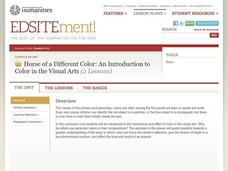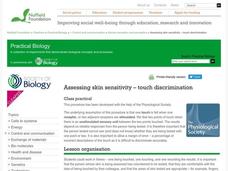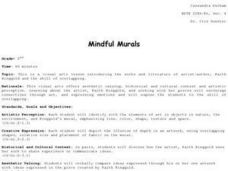Exploratorium
Thread the Needle
If you are setting up a rotation lab where learners are investigating vision at different stations, this activity can be used to explore depth perception. Setting up a giant needle eye, students attempt to pass a pencil through it with...
Urbana School District
Light
You matter, unless you multiply yourself by the speed of light ... then you energy. Presentation covers the behavior of light as both a wave and a particle, light versus sound, space travel, why objects have colors, depth perception,...
Curated OER
Horse of a Different Color: An Introduction to Color in the Visual Arts
High schoolers identify ways in which the artist uses color to draw the view's attention to points within the composition and creates a sense of depth. They discuss the effect of color on the tone and mood of an artwork.
Curated OER
How We Perceive Movement, Depth and Illusions
Students examine how depth perception works through a class experiment. They design and perform their own experiment that investigates visual illusions.
Curated OER
In Depth with the Full Spectrum
Students explore the basic color wheel and the ways that artists use color to guide the viewer's attention through a painting's composition. A creation of a sense of depth in a two dimensional space and the effect of color on mood and...
LABScI
Vision Lab: The Eye
Our bodies have some amazing capabilities, but there are some limitations. Explore the limitations of the human eye through the eighth lab activity in a series of 12 biology lessons. Individuals measure their own peripheral vision and...
Exploratorium
Depth Spinner
Put a new twist on your collection of optical illusion activities. Affix the linked printable spiral to a drill, record player, or some other rotating tool. Have learners stare at the spinning disk for only 15 seconds and then look away....
K20 LEARN
The History of Spoken Word Poetry: Historical and Cultural Perspectives In Literature
Spoken word poetry, more than almost any other form, reveals the historical and cultural perspective of the poet. High schoolers listen to various spoken word poems, select one to research in-depth, and then apply what they have learned...
Curated OER
A World Without Color And A World With Color
Sixth graders create black and white pictures followed by a re-creation of the same picture using color with an emphasis on contrast, depth, and mood.
National Endowment for the Humanities
Lesson 1: In Depth with the Full Spectrum
High schoolers study the ways in which an artist can use color. They view various images of artwork and discuss the effect of color on spacial dimensions, focal points, tone, and mood.
Curated OER
Letters from Emily Dickinson: Letters and Poems
Students analyze how Emily Dickinson perceived herself as a poet. Students read correspondence between Dickinson and her preceptor, Mr. Higginson to determine the depths of their relationship. Students interpret several of her poems.
National Endowment for the Humanities
In Emily Dickinson's Own Words: Letters and Poems
Analyze the depth and beauty of American Literature by reading Emily Dickinson's letters and poems. The class analyzes Dickinson's poetic style and discusses Thomas Wentworth Higginson's editorial relationship with Dickinson. They pay...
US Institute of Peace
Governance, Corruption and Conflict Simulation on Nepal
Can your class help the people of Nepal? Scholars take an in-depth look into the social injustices and struggling economy of a country in turmoil during a multi-day role-playing exercise. After reviewing information on the problems...
Nuffield Foundation
Assessing Skin Sensitivity—Touch Discrimination
How do we distinguish between the number of things touching our skin? Scholars explore an interesting lesson through an experiment. They learn that there must be an unstimulated sensory unit between two touches to distinguish them. They...
Curated OER
Horse of a Different Color: An Introduction to Color in the Visual Arts
Students examine how artists use color to create a sense of depth in a two-dimensional space. They view and analyze prints, complete worksheets, and write a paragraph on how color is used to draw the viewer's eye to a central figure.
Serendip
How Do We Sense the Flavors of Food?
We taste with our taste buds, so why do flavors change when we have a stuffy nose? Scholars experiment with taste testing while holding their noses and then while smelling. They record their observations in pairs and come together to...
American Museum of Natural History
Optical Illusions and How They Work
Illusions are what your mind makes them. Learners view several optical illusions. After each illusion the resource describes what is seen and the potential connection to evolution of the brain. Illusions include seeing different objects...
Curated OER
COLORFUL LAYERS AND DECORATIVE PATTERNS
Young scholars view and discuss the work of Trudy Kraft and then create a batik project based on her ideas of pattern and depth of overlapping color in a transparent medium.
Curated OER
A World without Color and a World with Color
Visual arts instructional activity involving the creation of a black and white picture followed by a re-creation of the same picture using color with an emphasis on contrast, depth, and mood.
Curated OER
Mindful Murals
Second graders depict the illusion of depth in an artwork, using overlapping shapes, relative size and placement of fabric on a mural. They identify with the elements of art in objects in nature, the environment, and Ringgold's mural.
Curated OER
Dyspraxia Presentation
Not really a resource for use in the classroom - this file is a PowerPoint presentation which gives information about Dyspraxia. It is a very interesting presentation because it shares many signs to look for in a person who may be...
Institute of Electrical and Electronics Engineers
Virtual Reality and Anaglyph Stereoscopic Technology
Experiment with 3-D glasses to learn about stereo images and virtual reality. Scholars look at various images to determine if green/red or red/cyan glasses are preferable. They determine distances between images using the 3-D glasses and...
Curated OER
Discover Picture-Perfect Projects
Use classic, well-loved picture books as means of infusing visual and language arts in the elementary classroom.
Howard Hughes Medical Institute
Explore Your Inner Animals
Human bodies prove evolution thanks to our genes, bones, and more. Learning about specific body parts and how they evolved from other species helps individuals better understand the transition species that helped us become who we are today.

























